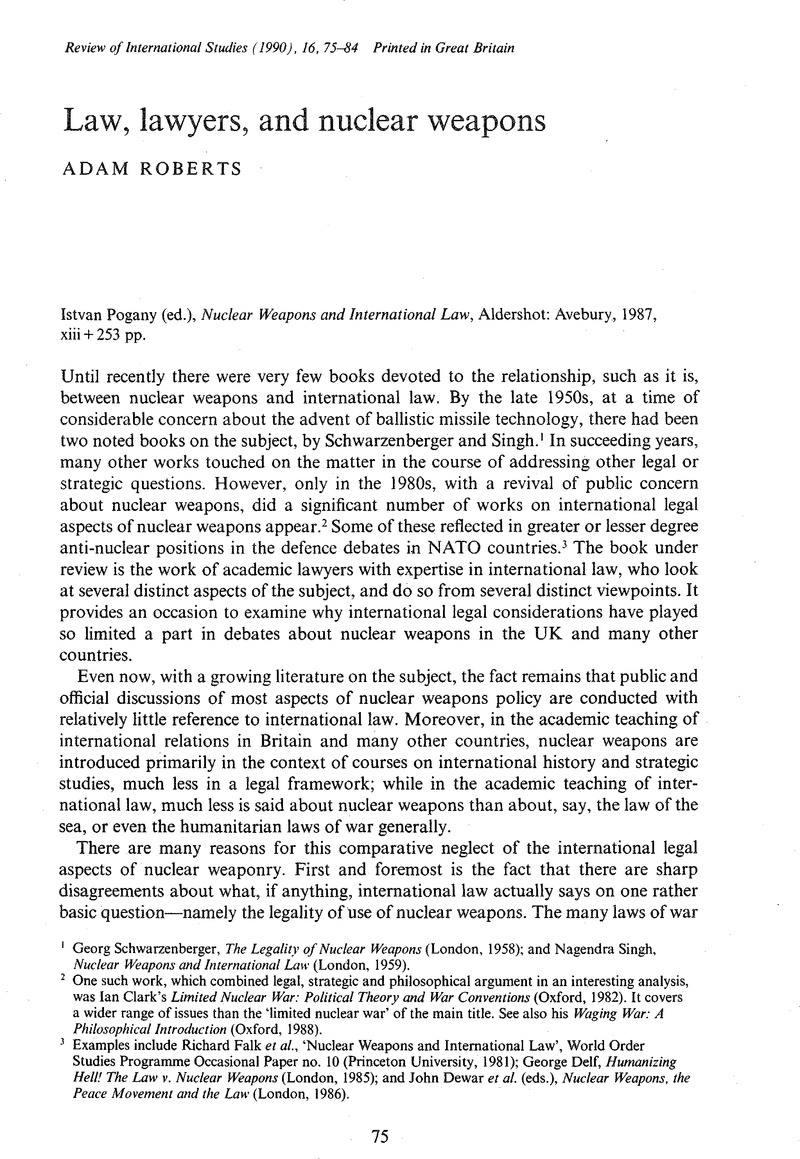Published online by Cambridge University Press: 26 October 2009

1 Schwarzenberger, Georg, The Legality of Nuclear Weapons (London, 1958)Google Scholar; and Singh, Nagendra, Nuclear Weapons and International Law (London, 1959).Google Scholar
2 One such work, which combined legal, strategic and philosophical argument in a n interesting analysis, was Clark's, IanLimited Nuclear War: Political Theory and War Conventions (Oxford, 1982)Google Scholar. It covers a wider range of issues than the limited nuclear war' of the main title. See also his Waging War: A Philosophical Introduction (Oxford, 1988).Google Scholar
3 Examples include Richard Falk et al., ‘Nuclear Weapons and International Law’, World Order Studies Programme Occasional Paper no. 10 (Princeton University, 1981); Delf, George, Humanizing Hell! The Law v. Nuclear Weapons (London, 1985)Google Scholar; and Dewar, Johnet al (eds.), Nuclear Weapons, the Peace Movement and the Law (London, 1986).CrossRefGoogle Scholar
4 From the introduction to Roberts, Adam and Guelff, Richard (eds.), Documents on the Laws of War (Oxford, 2nd edn, 1989), pp. 18–19.Google Scholar The reservations to 1977 Geneva Protocol I, with their direct and indirect references to nuclear weapons, are on pp. 465–8.
5 Root, Elihu, Addresses on International Subjects (Cambridge, Mass., 1916), p. 129.CrossRefGoogle Scholar
6 Acheson, Dean in Proceedings of the American Society of International Law (1963), p. 14.Google Scholar
7 Most notably, of course, Bull, Hedley, The Control of the Arms Race (London, 1961).Google Scholar
8 For a sophisticated discussion of counter-force in the light of distinctions between civilian and military targets, see Turner Johnson, James, Can Modern War Be Justl (New Haven, Conn., 1984), pp. 129–149.Google Scholar The main disadvantage he perceives in a counter-force strategy is the risk of enormous civilian collateral damage in a war, rather than the threat to strategic stability in peacetime.
9 Including the UK.and USA, neither of which has ratified 1977 Geneva Protocol I. The implications of this Protocol for the conduct of military operations have been one factor—quite apart from the issue of the status of certain irregular forces—in making major powers cautious about ratification. France, at accession to 1977 Geneva Protocol II (which deals with non-international armed conflicts) on 24 February 1984, indicated in a statement that it was not acceding to Protocol I because of ‘the lack of consensus among the signatory states of Protocol I as to the exact meaning of the obligations they have undertake n so far as deterrence is concerned’. China acceded to Protocol I on 14 September 1983, with a minor reservation not related to the nuclear issue. The USSR ratified Protocol I in August 1989.